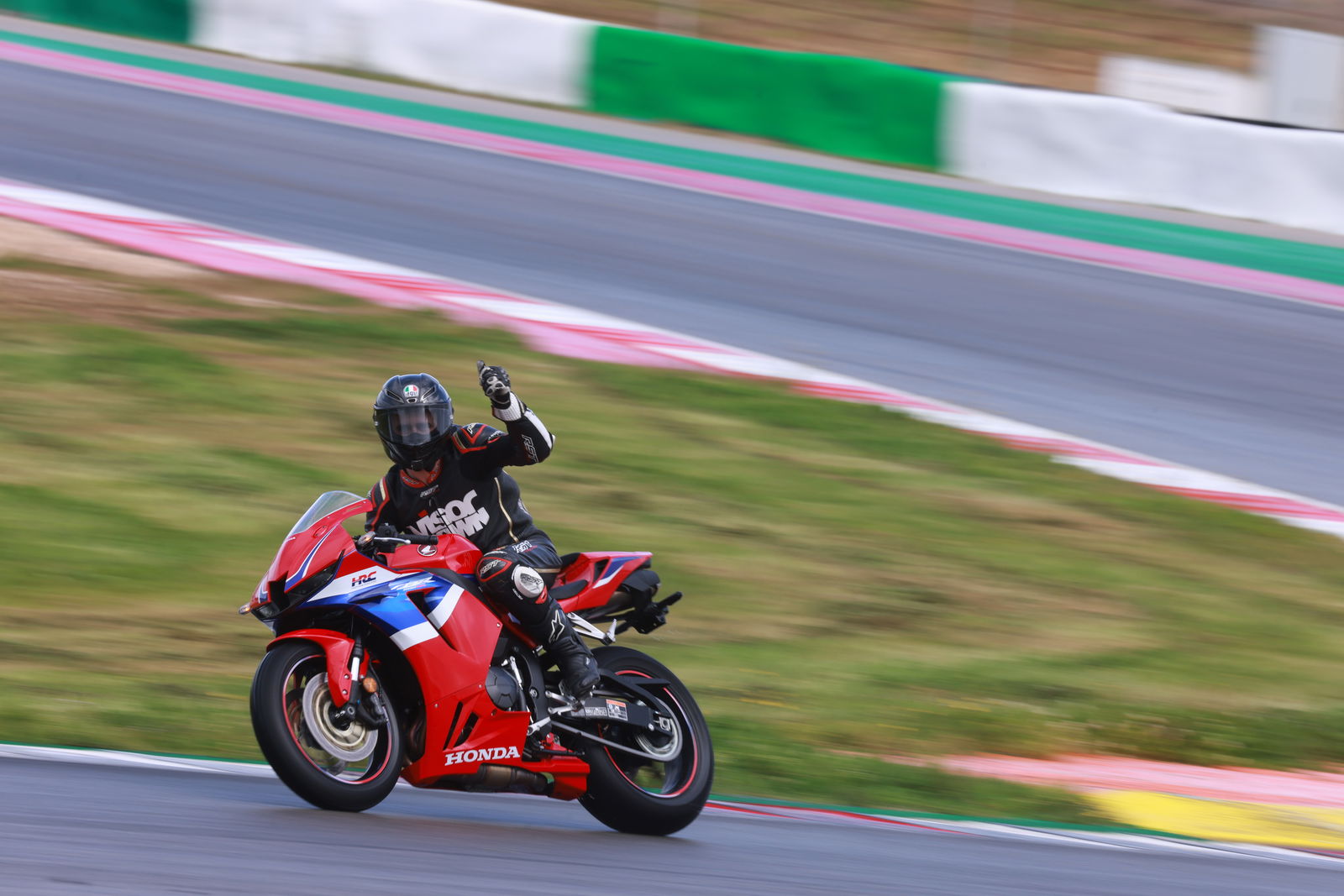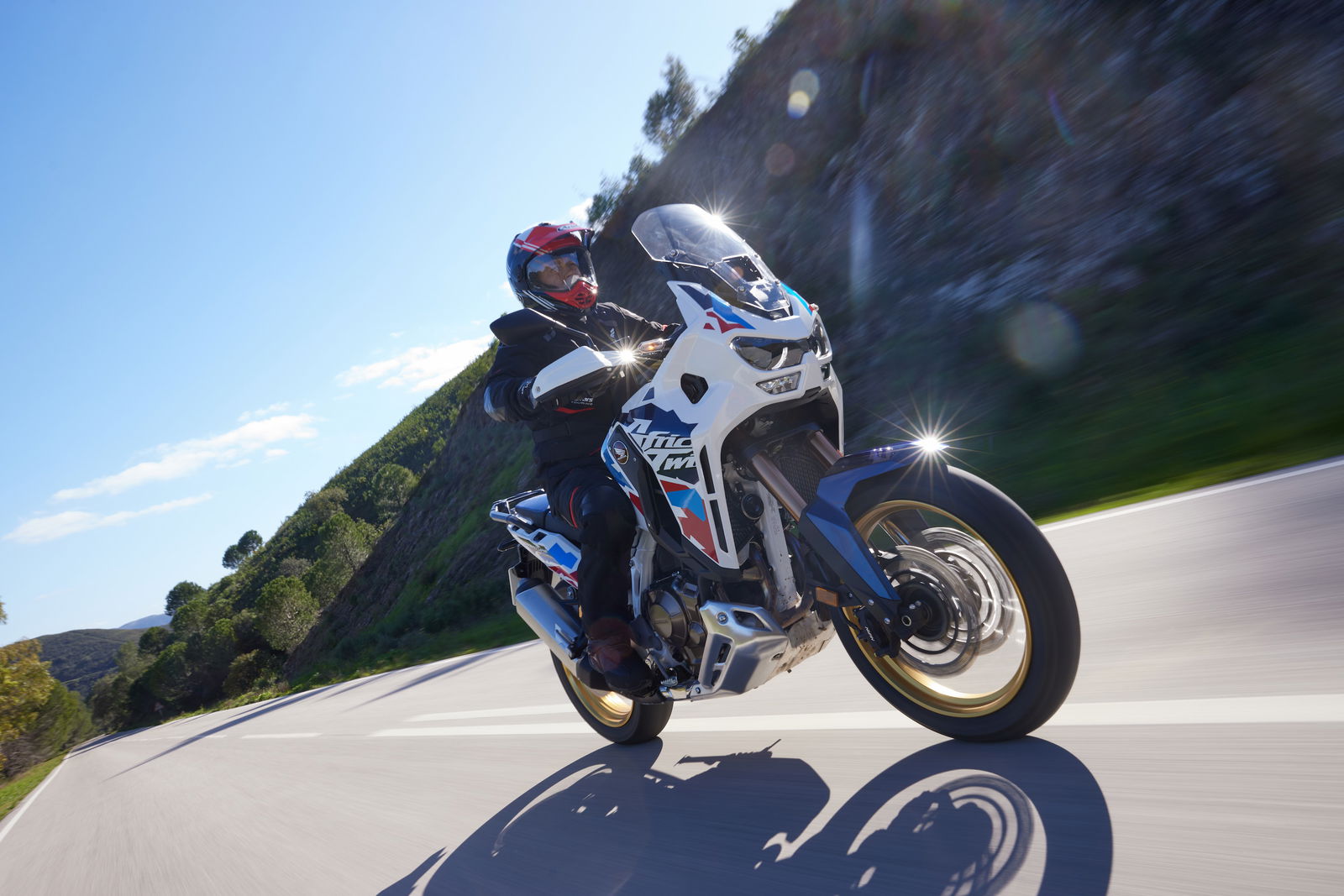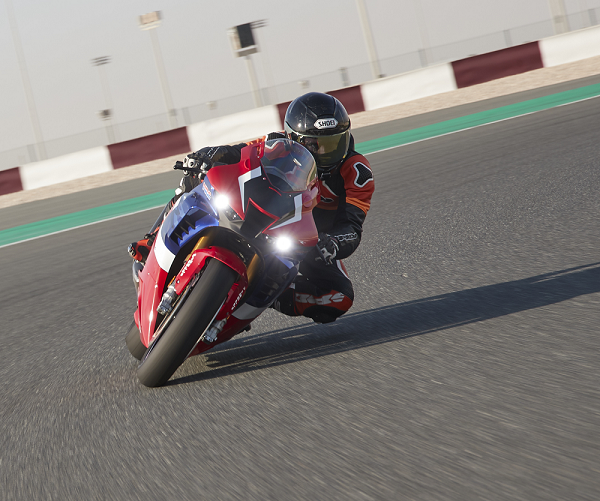Donington Park on the XSR900 GP
The Yamaha XSR900 GP is for ‘Rose Tinted Racers’, according to Yamaha, but can it back up its styling with genuine ability?

Yamaha has a long history in motorsport (yes, even the four-wheeled kind) and has played a particularly significant part in the world of motorcycle racing. Its links go back more than 50 years, but there is one period of time, often referred to as the ‘Golden Era’, that the new Yamaha XSR900 GP is looking to highlight.

It is, of course, the late 1970s and 1980s when grand prix racing motorcycles were ferocious, fast, and yet somehow elegant in a way that a modern motorcycle could only dream of. With no awkward winglets and appendages, bikes like the YZR500 were famed machines, and they captured the imagination of race fans and road riders alike.
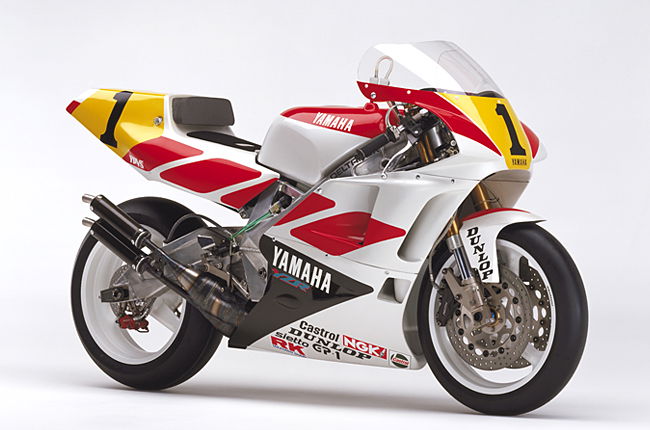
Even I can remember visiting the bike show at the NEC with my dad and being utterly awestruck by the sight of a gobsmacking OWC1 even as a snotty-nosed 10-year-old. Today I’m standing outside a swanky boutique hotel on Portugal’s Atlantic coast, and that same feeling of ‘WOW’ is creeping over me as I look down at the new XSR900 GP. Finished in that evocative Legend Red colour scheme (just don’t call it Marlboro!), with hidden lights and footpegs it looks every inch the factory race bike for the road.
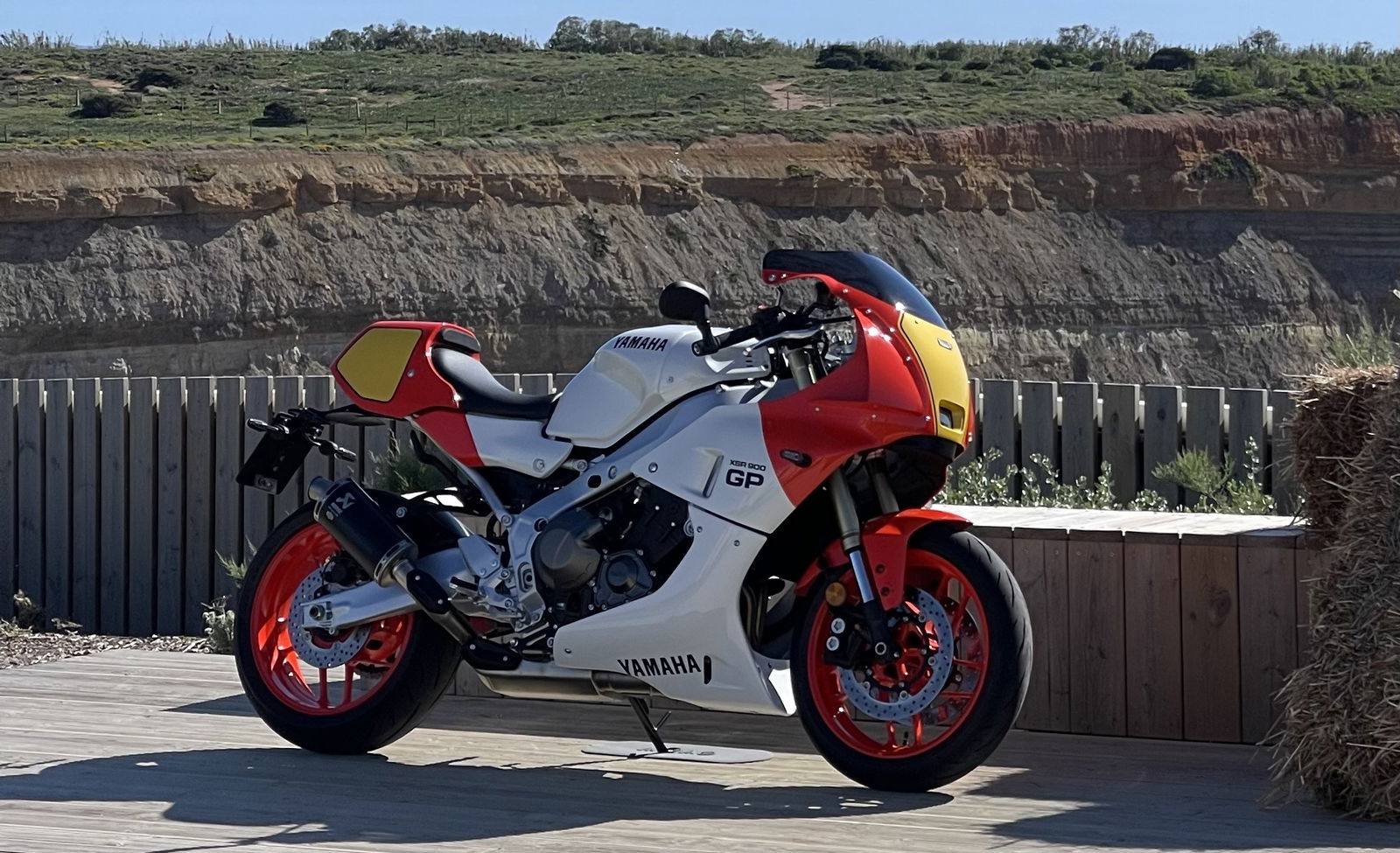
We weren’t here to simply look at the new machine, though, we were here to test it. With unusually warm and sunny weather overhead, we set off for a short road ride to the Circuito do Estoril for some photo and video opportunities, and then a longer road ride again in the afternoon. When all was said and done we’ll have travelled around 170km and been on the bikes for around seven hours.
XSR900 GP price, colours and availability
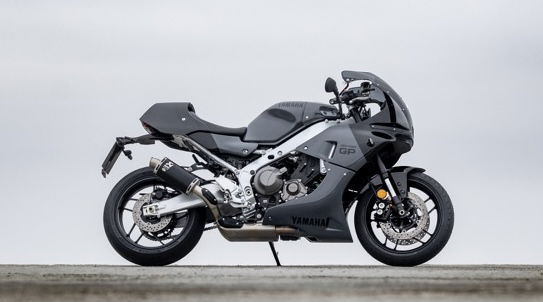
The new XSR900 GP in Stealth Black with the Racer Pack (Belly pan, exhaust and other parts) fitted
The new bike comes in two colours, Legend Red (the Marlboro-looking one) and Stealth Black. If the Legend Red didn’t exist no one would care, but it does and if you buy the black and grey bike you’ll hate yourself every time you see a red and white bike on the road.
Also, you might be a little disappointed by only the two colours to choose from, but the possibilities are endless; Gauloises blue, Speedblock yellow, Lucky Strike… there are so many paint jobs this could morph into.
Both colours are £12,506 OTR. If you want the full-fairing (large belly pan) it’ll be another £599. The Racer Pack - which includes a full-system Akrapovic among other goodies - is £2,950. That’s pushing the little GP replica up to near final generation R1 (RIP) money. And I’ll leave it up to you to decide if that’s good value or not.
Bikes are expected to be in UK dealerships by the end of May 2024 and enquiries can be made to your local dealer or the Yamaha website.
What’s new with the XSR900 GP
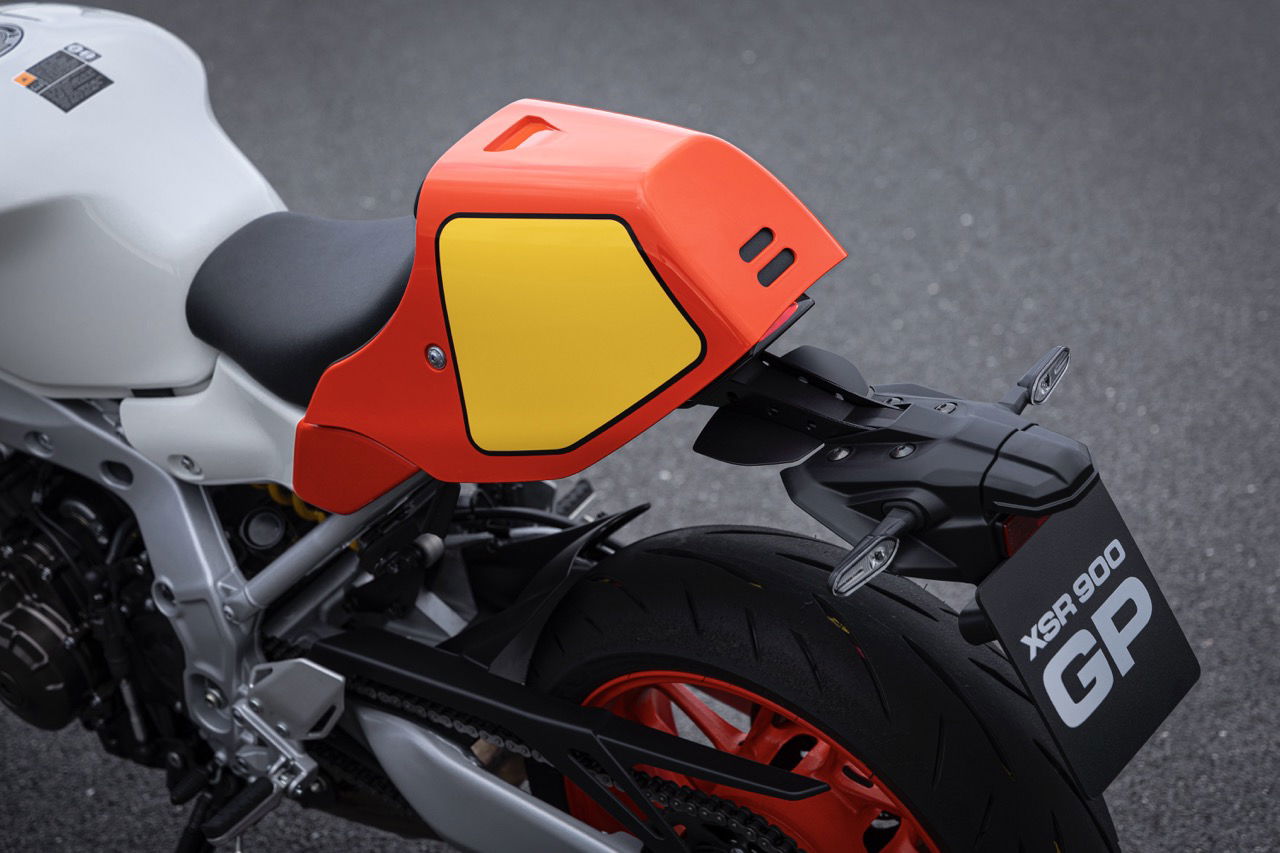
As mentioned above, the bike shares its main components with the already-released 2022 Yamaha XSR900 naked bike. Therefore, the engine, main frame, suspension and brakes are shared with the regular XSR, but not all of those parts are exactly the same. It would be doing Yamaha a disservice to say that, and when you drill down quite a lot has been altered.
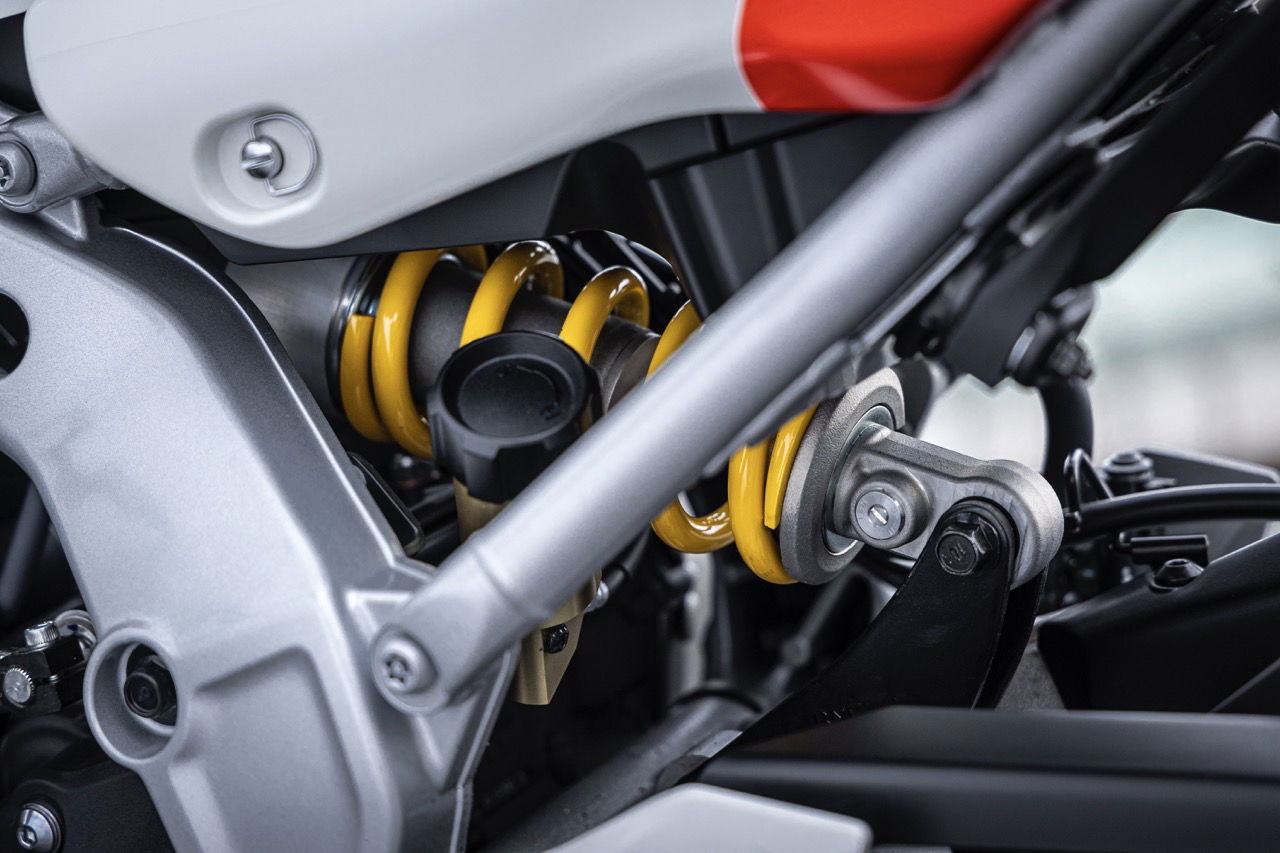
The frame, for instance, has been changed for the GP, and features increased rigidity around the headstock and revised engine mounts. The steering stem shaft of the GP is also aluminium, the only CP3-powered bike in the range to feature this. The new XSR900 GP also features a subframe that is reinforced over the one found on the stock XSR900.
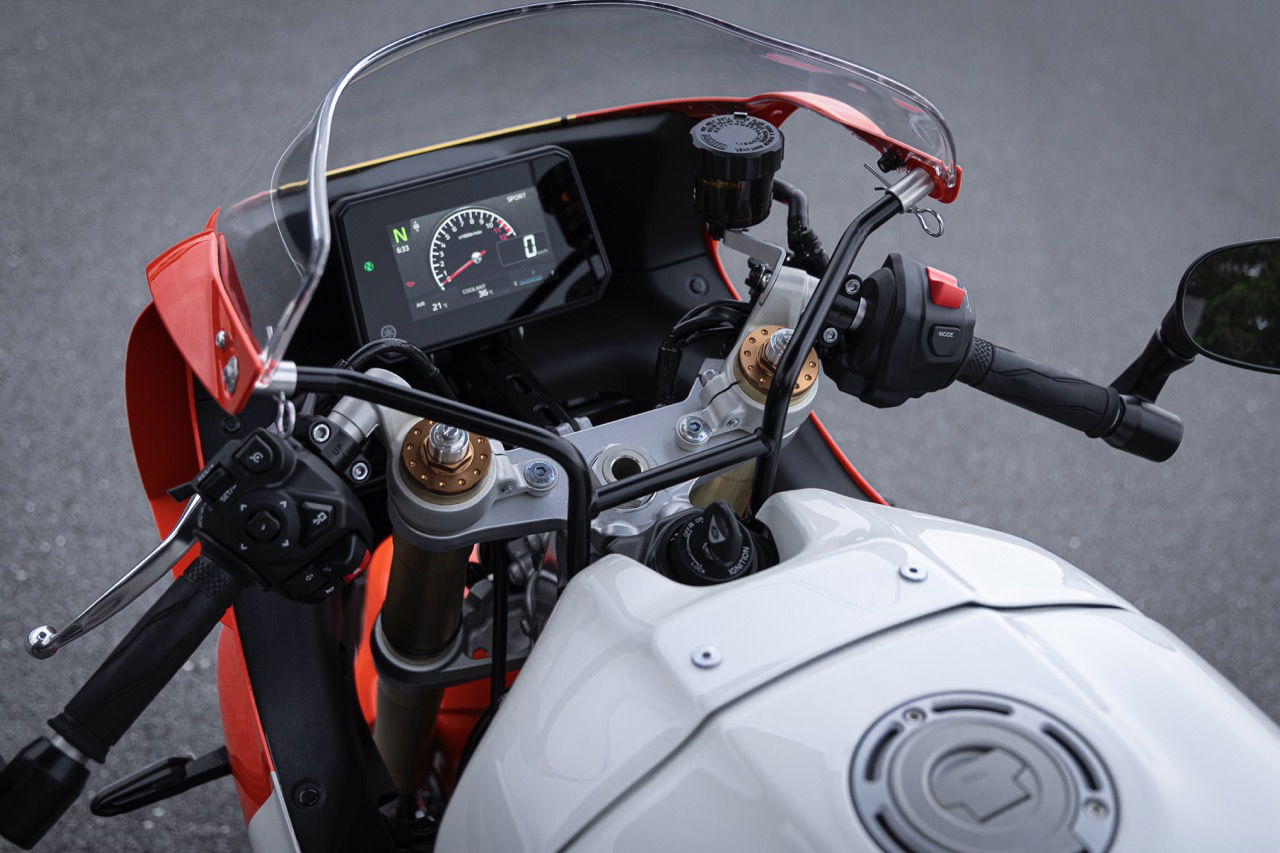
Front forks are all new and longer than the naked model to accommodate the clip-on bars mounted above the top clamp which is also different. In fact, the new forks also add 5mm to the front ride height while the wheel travel remains unchanged. The suspension also differs in the amount of adjustability on offer though, with the GP giving you high and low-speed compression damping adjustment and more clicks - 5.5 clicks of high speed and 18 clicks of low speed. You also get more clicks of rebound damping - 26 as opposed to the 11 clicks you get on the stock XSR900. It’s also got revised spring rates and 130mm of travel. Preload at the front is as before, with free adjustment over 15mm.
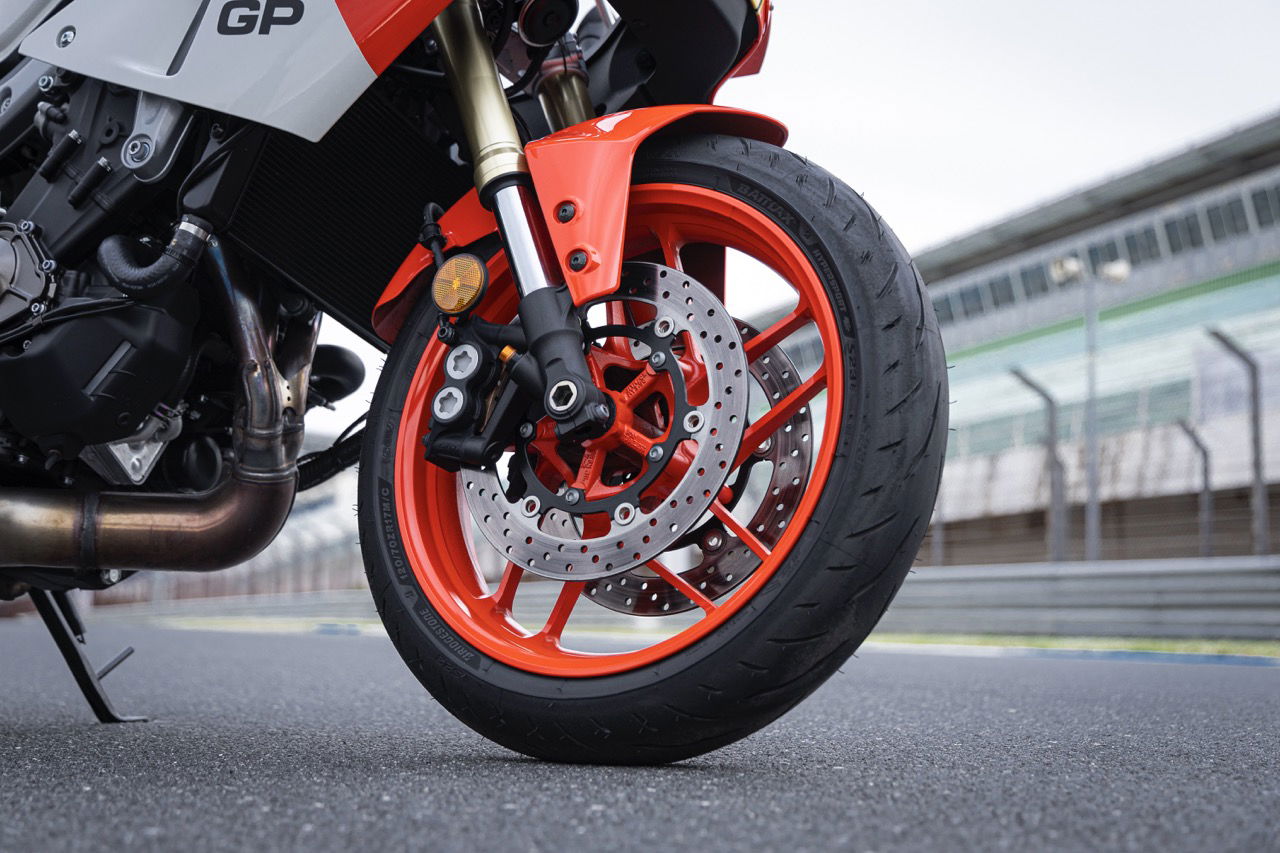
It’s a similar story at the rear, with a KYB fully adjustable shock that now features a hydraulic remote preload adjuster (24 clicks), high- and low-speed compression damping (5.5 clicks and 18 clicks respectively), and the same 2.5 clicks of rebound damping control as the naked XSR900. You get 131mm of travel at the rear.
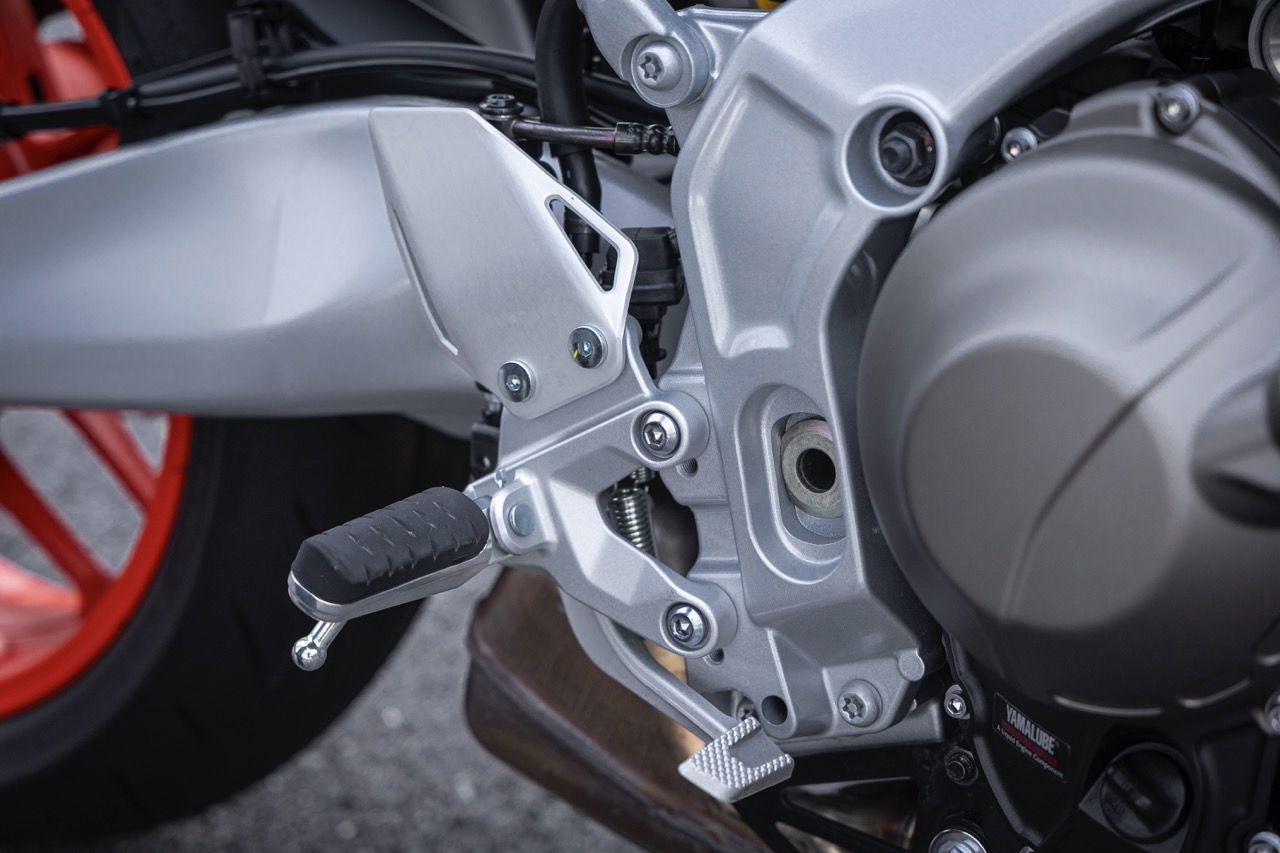
Like the naked bike it's based on, the GP wears a swingarm that differs from the other CP3 hyper nakeds and uses an item that has more in common with the one found on the Tracer 9 sports tourer, although even then, it’s not ‘exactly’ the same.
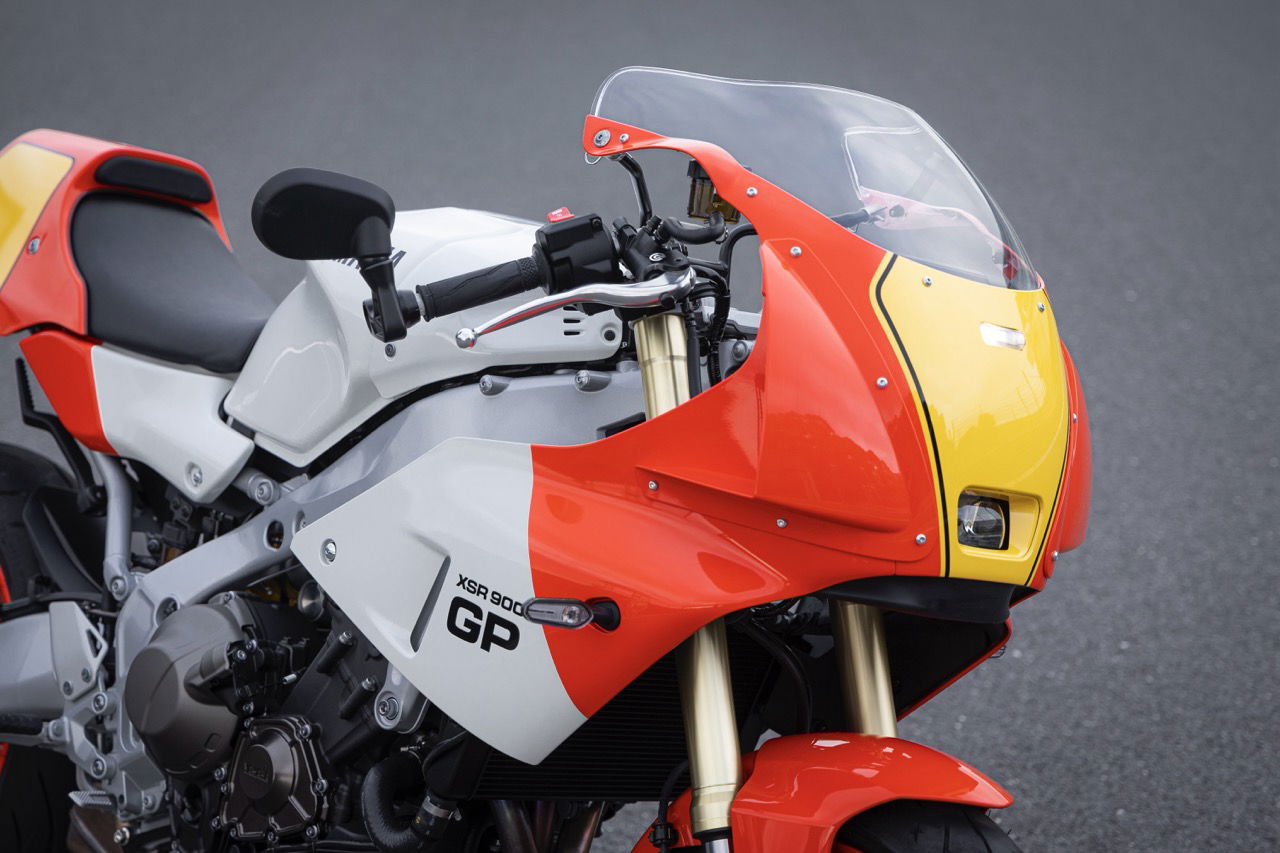
Finally comes the biggest change, the styling. The GP is styled by an ‘era’ and not any model in particular, meaning as you sit back and look at it you can pick up elements of famous TZ250s and the famous YZR500 race bikes - primarily the OW70, OW76, OW98, and OWD3. It’s a very faithful homage to those machines, with the bolt-on wind deflectors and fairing stays looking like they’ve been plucked from a pile of New Old Stock parts in some abandoned Yamaha storage facility.
Handling
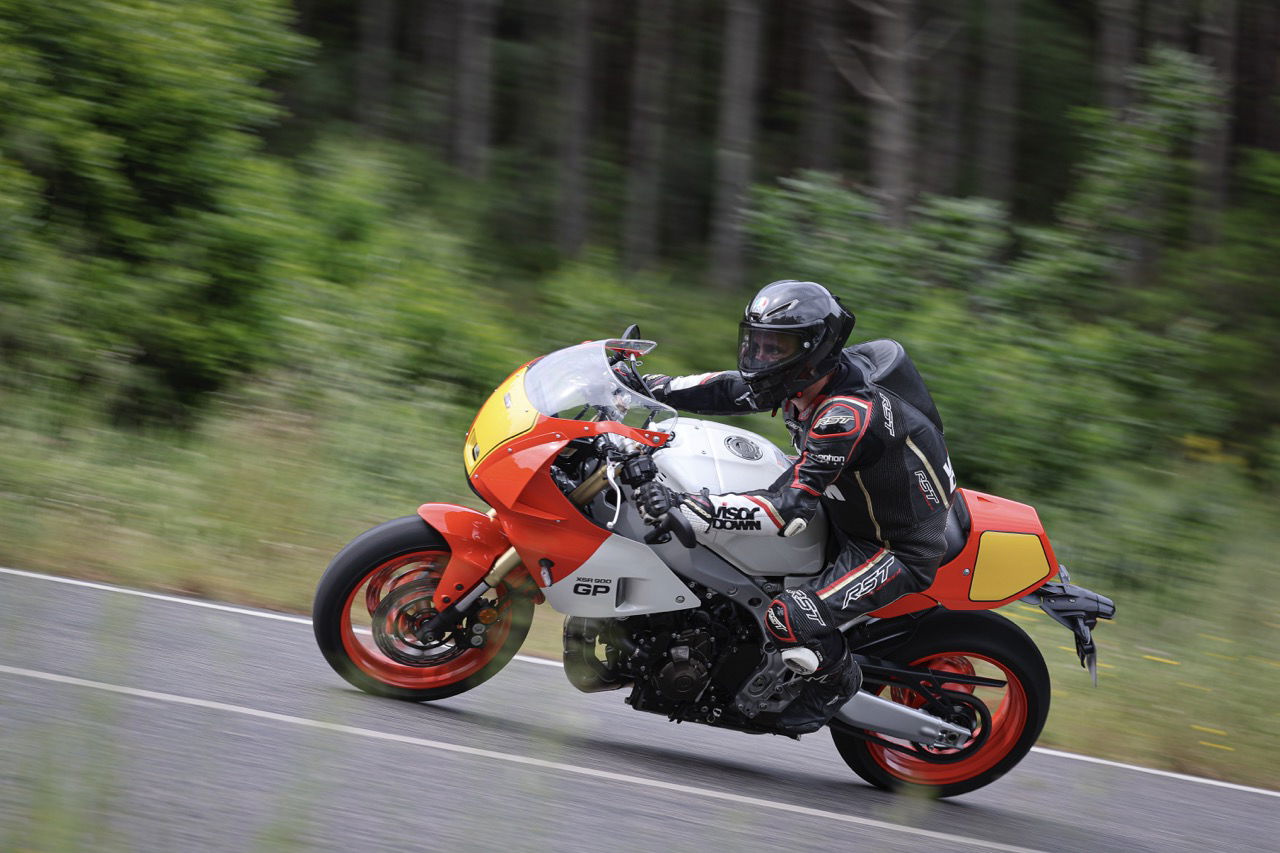
As mentioned, we only had a short 45-minute squirt to Estoril to take part in our ‘curated photo and video’ sessions. But the roads were dry and warm and it was enough to gain an insight into how the GP handles. The main takeaway is that it’s a very different bike to the XSR900. You’ve got to be slightly more aggressive with the bars if you want to push on, and with its narrower clips-ons placing more of your weight on the front end of the bike, it's dynamically a very different animal compared to the naked.
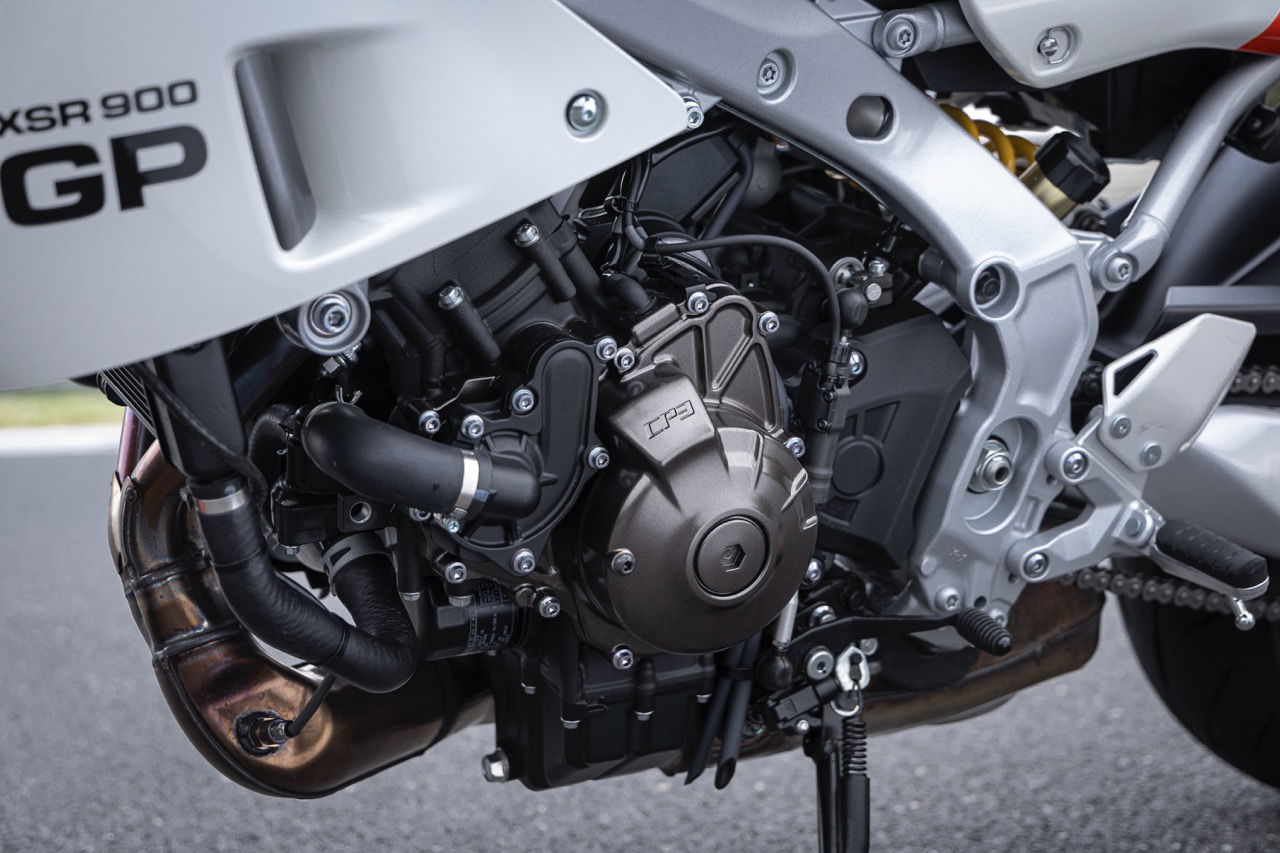
The engine is very close to the tune of the XSR900 although the riding modes and other electronics have been revised to suit the retro sports bike. It does though have a slightly different character which I think is down to the upper fairing. The engine of the stock bike is totally unshrouded and therefore any of the clatter and induction noise from the top-end of the engine is released into the wild. The GP, though, has this lovely bikini fairing wrapping the bike on each side. I think it’s this channelling the sounds up to the rider that makes it sound a little more raucous.
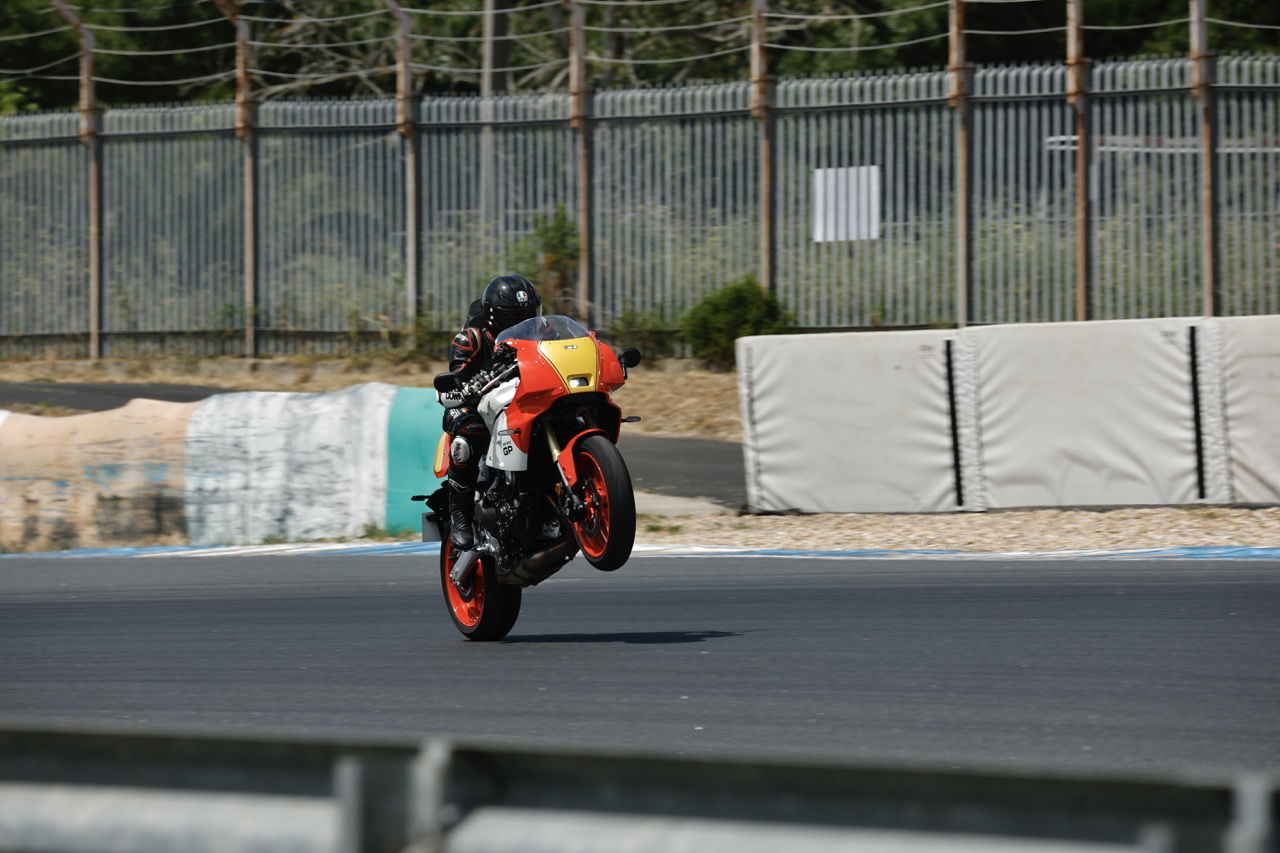
No sooner have these conclusions been drawn than we have arrived at Estoril, a fitting venue for the XSR900 GP launch as it too has a long and rich history of hosting MotoGP (2000 to 2012), WorldSBK (1988, 1993, 2020 to 2022) and FIM World Endurance (1987, 2000, 2020, and 2021). With such a historic venue, some full laps of the track would have been ideal, although sadly only elements of it were open for use on the day meaning we had a couple of sections to play with.
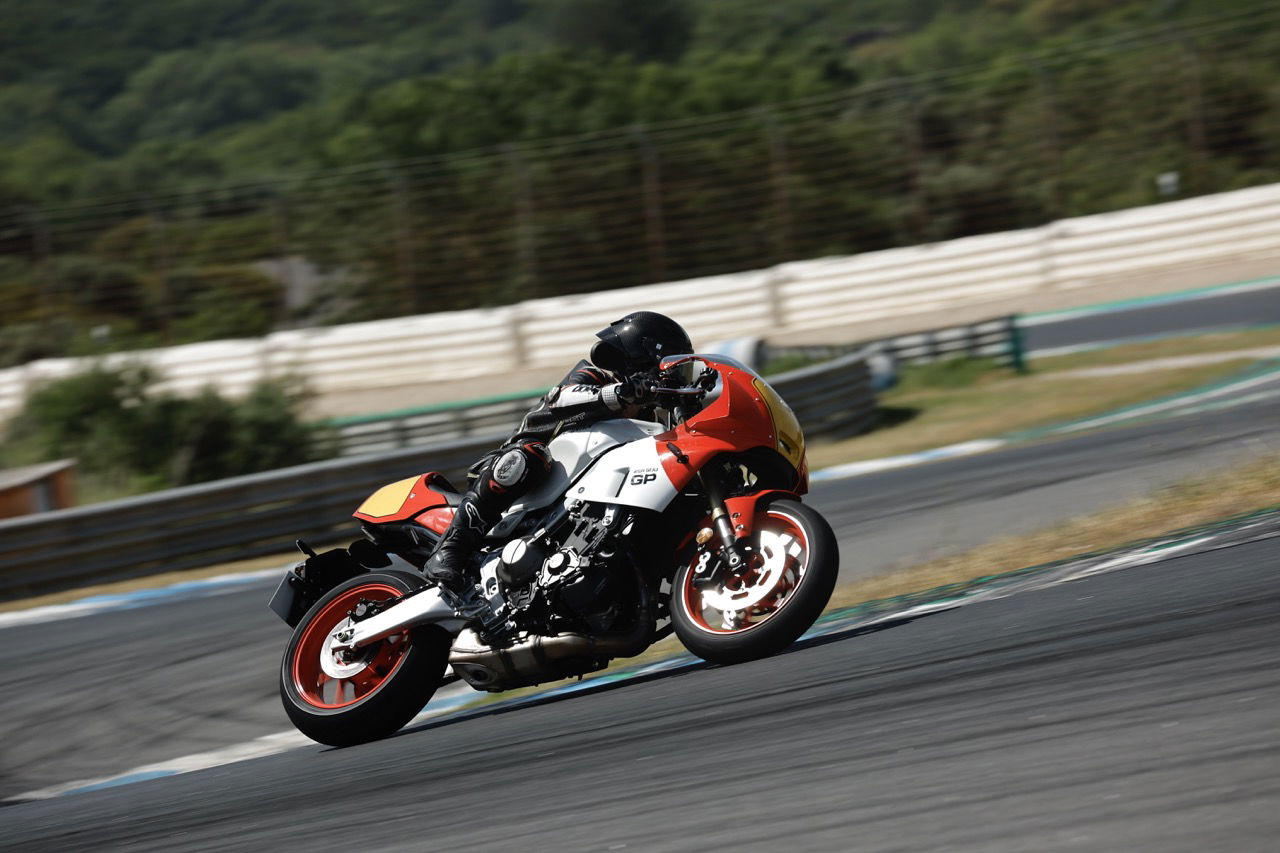
It was enough to get a good feel for the bike, though, and despite not running long enough to get the tyre fully up to temperature, the baking asphalt gave enough grip to begin beading the rubber up against the edge of the hoop. And it’s all good news, the GP is definitely not a bike that is all show and no go. The engine is a belter, with a torque-rich mid-range and a race to the redline that’s addictive. The brakes have a nice progressive feel when you pile on the anchors, while the increased wheelbase over the stock XSR900 (1,500mm compared to 1,495mm) and revised stance give the bike lovely stability on Estoril’s long third-gear final corner. Even a late full chat upshift to fourth at maximum revs can do little to upset Yamaha’s lovely little applecart.
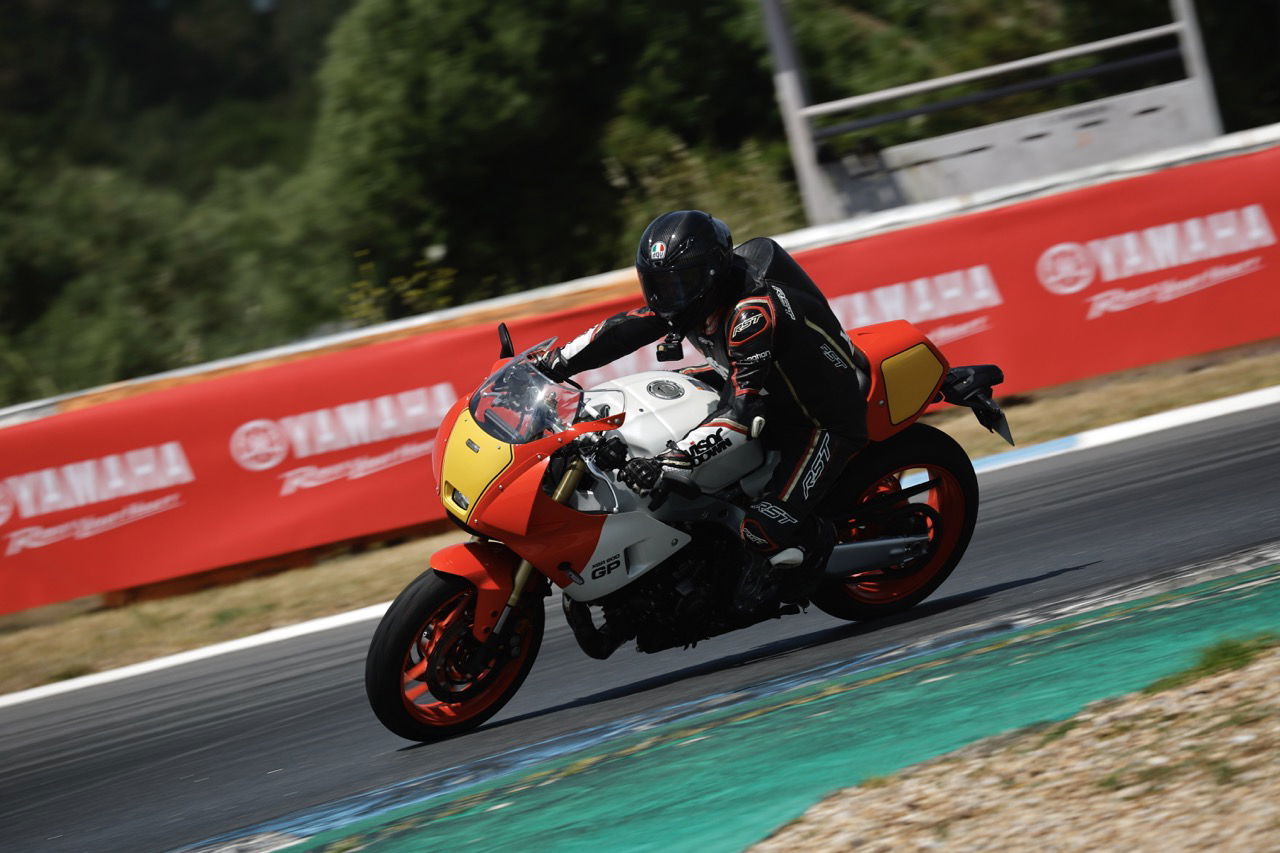
If I’m being critical, the only area where the bike didn’t feel at home was the ridiculously nadgery uphill left-to-right chicane. And I am being critical here because the layout and camber of this section of corners makes me think pretty much any road bike would feel a little bit clumsy. It flicks from side to side quickly enough, it just doesn’t feel totally happy in this one section of the track. You can tell this bike thrives on corner speed and being spanked through a fast turn - of which Estoril has quite a lot.
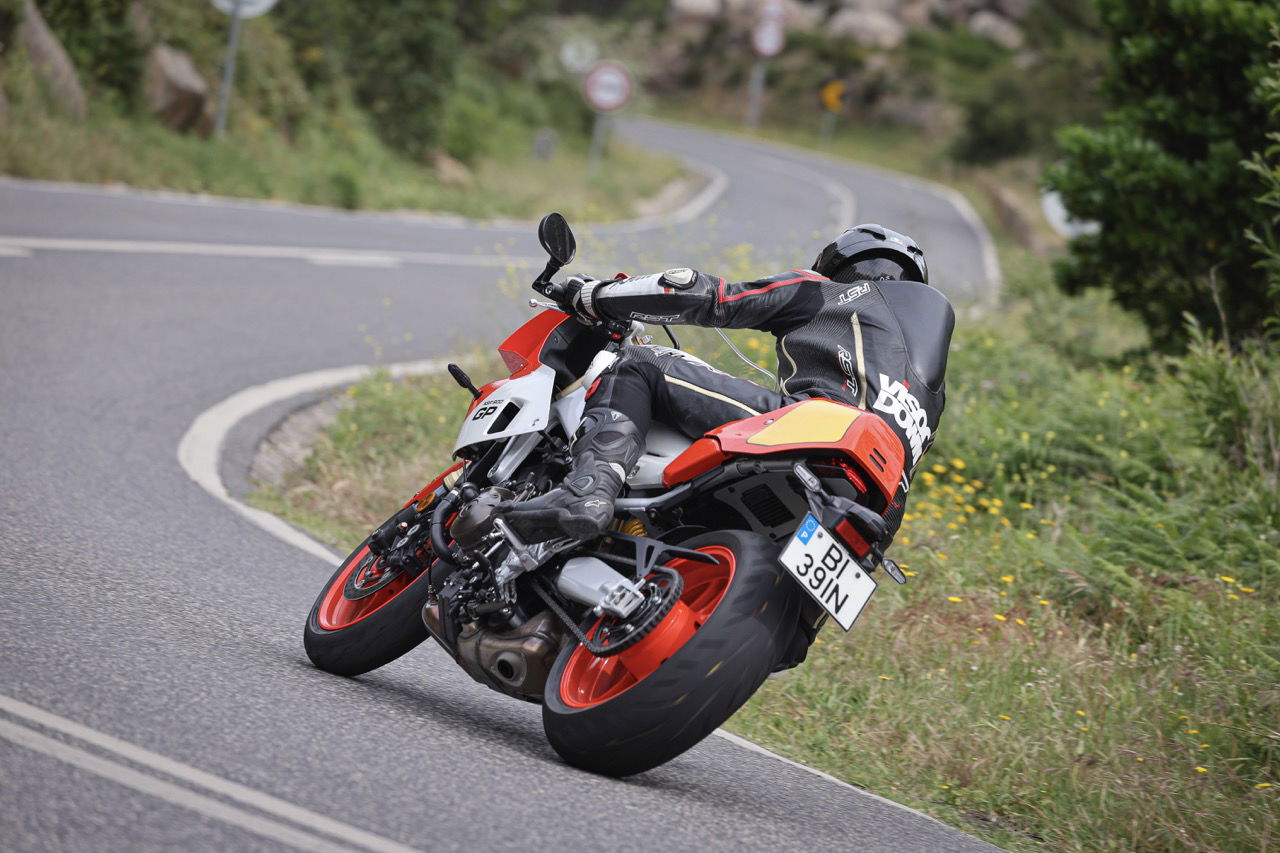
With the track riding now done we head out into the baking noon sunshine for the culmination of our road ride, which features flashes of good road quickly followed by dreary sections of towns and villages. These built-up sections do at least mean we can see what it’s like around town, and as you’d expect from a bike closely related to a 900cc naked, it’s pretty good news. In the Road and even Sport riding mode the delivery is controllable and the throttle connection is refined and accurate. The brakes are strong and not overly sharp, while the revised suspension feels, despite its reduced travel over the XSR900 naked, composed over bumps, lumps and potholes.
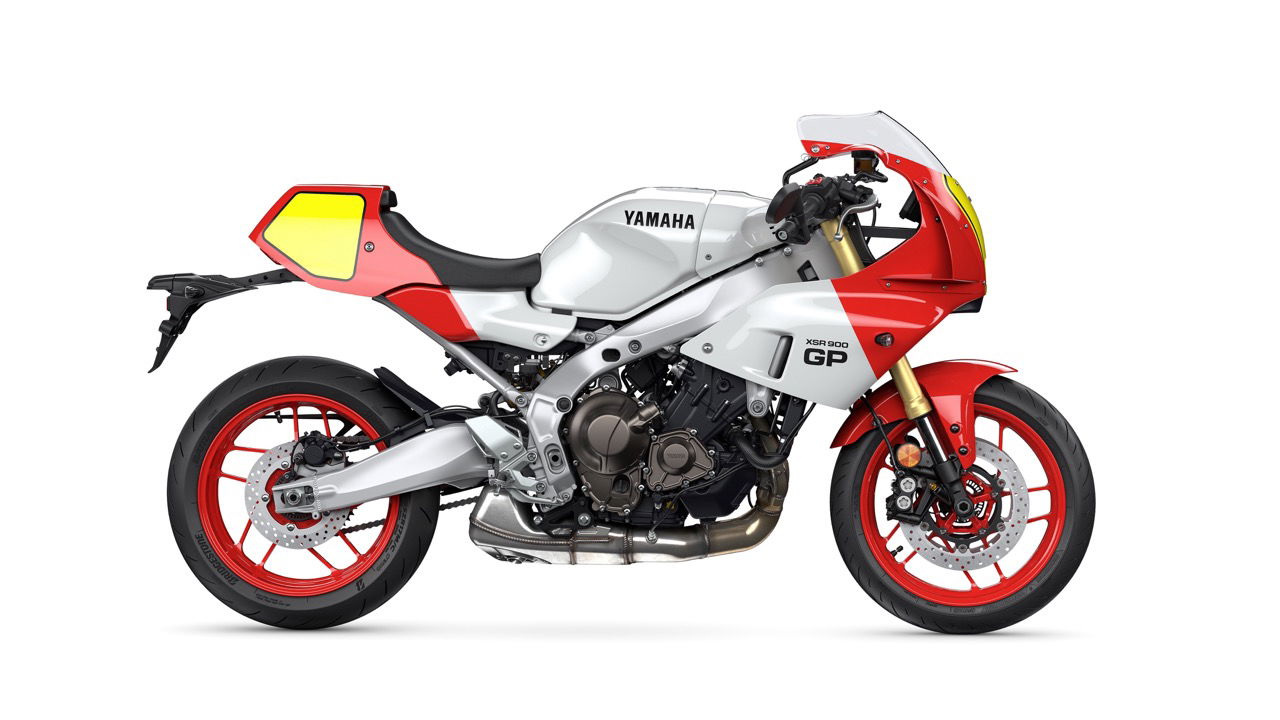
If there is one fly in the ointment with this kind of riding it's the comfort. With long stretches of the launch seeing us trickle along at a snail's pace and mostly caught up in traffic, I’m bearing much of my weight on my arms, and my wrists are paying the price. The tank is big enough to grasp nicely between my legs, but my RST suit is quite slippy and some tank grips for the GP would definitely be on my wish list if I bought one.
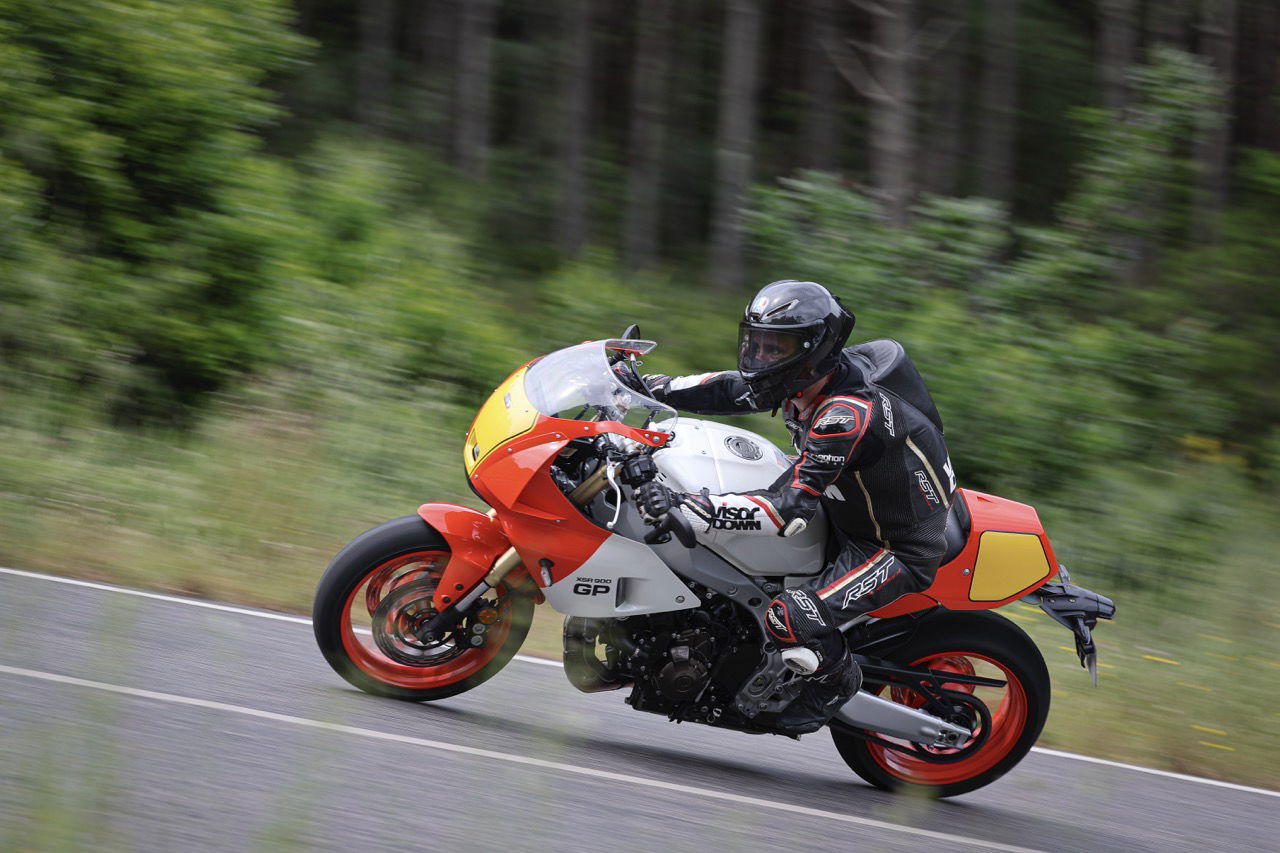
The lower body ergos are slightly more aggressive than those of the XSR900, with the ‘pegs on the GP sitting 26mm higher and 26mm further back. I didn’t feel it on the day we rode, but climbing up the steps to take the flight home from the launch there was some aching in the inner thigh region - although I am cracking on a bit, so it could just be that!
It’s a shame that the launch ride was so stop-start in nature, as I think had we been hammering up the beautiful, fast and sweeping Ronda Road in Spain it’d probably have highlighted this quirk a little less.
Electronics
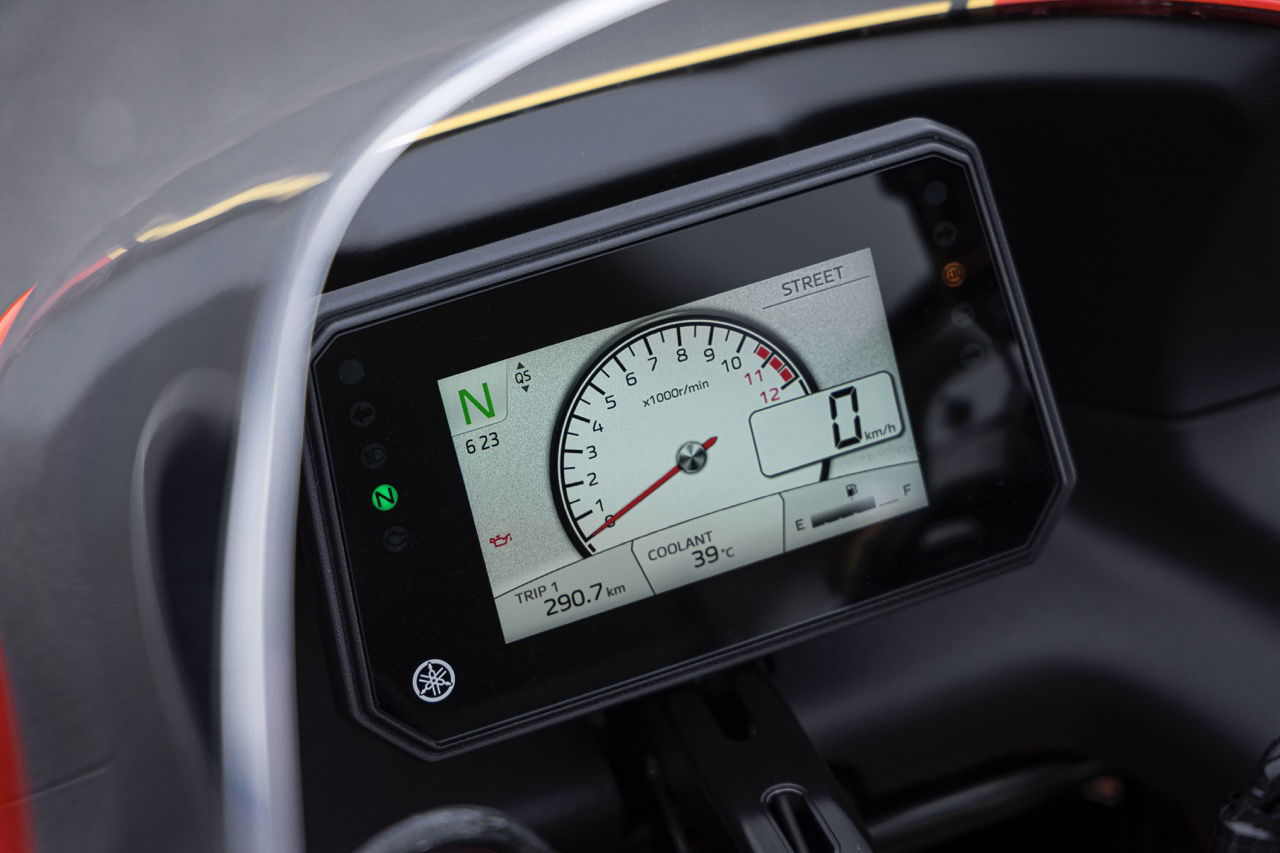
Even the TFT dash of the XSR900 GP is retro!
The real appeal of a bike like this, for someone like me, is the ability to have lovely late 70s and 80s superbike and Grand Prix styling with bang-up-to-date electronics, safety systems and reliability.
On all those fronts, I think the XSR900 GP smashes it. Up and down Q/S (the new third gen’ one too, which is very, very good), wheelie control, slide control, traction control, cornering ABS… It really has got the lot. If I have one gripe, it’s that the YRC menu within the TFT only has three intervention levels, which isn’t much, and I feel for some (especially those who might want to track day their bike) a little more adjustability would be nice.
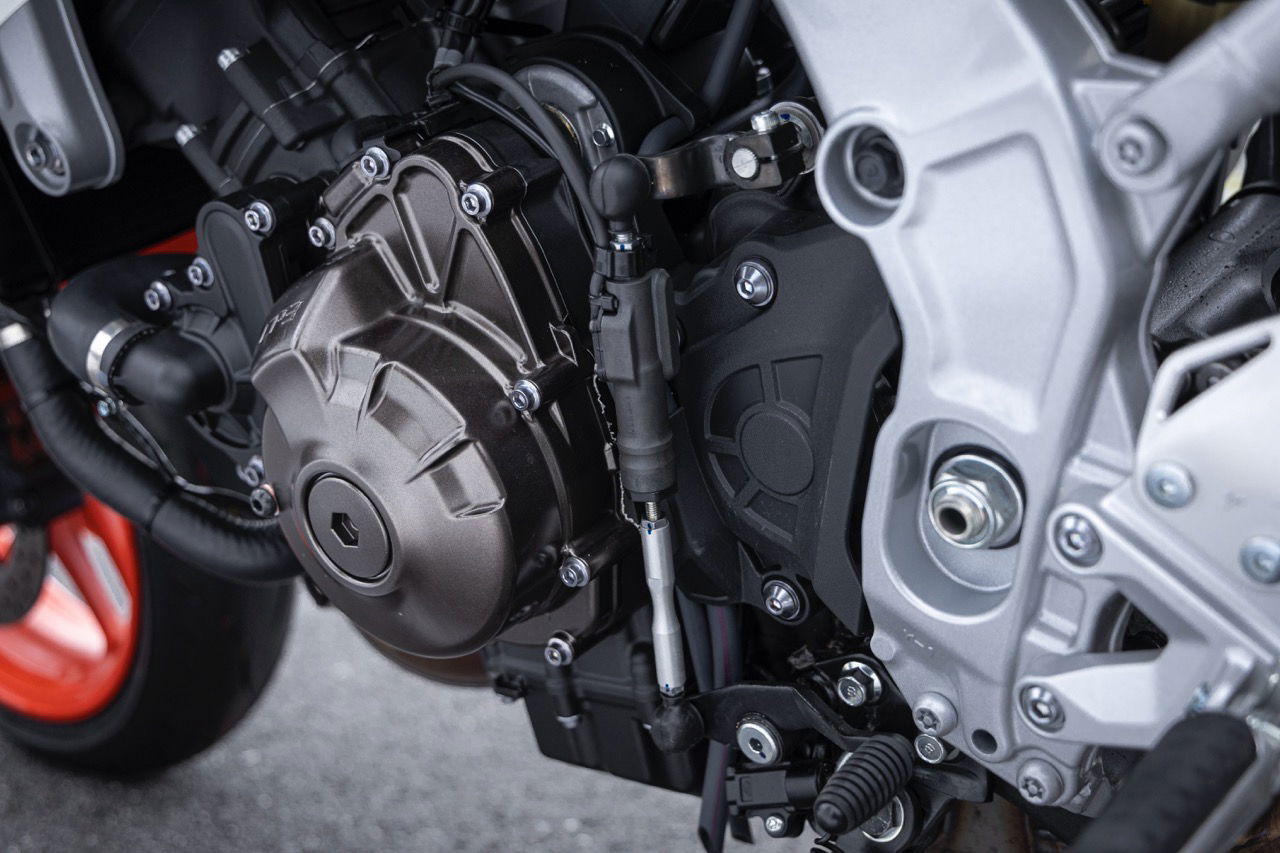
Another slight gripe on the electronics, although it’s not huge, is I’m still not a fan of this clumsy rocker switch indicator set-up. I didn’t like it on the MT-09 (which shares this design) and I’m still not a fan now. Aside from that, though, you have a full-colour easy-to-read TFT, with turn-by-turn navigation, calls, texts, music, an easy-to-use joystick and a simple mode button - the whole shebang.
Should I buy the XSR900 GP?
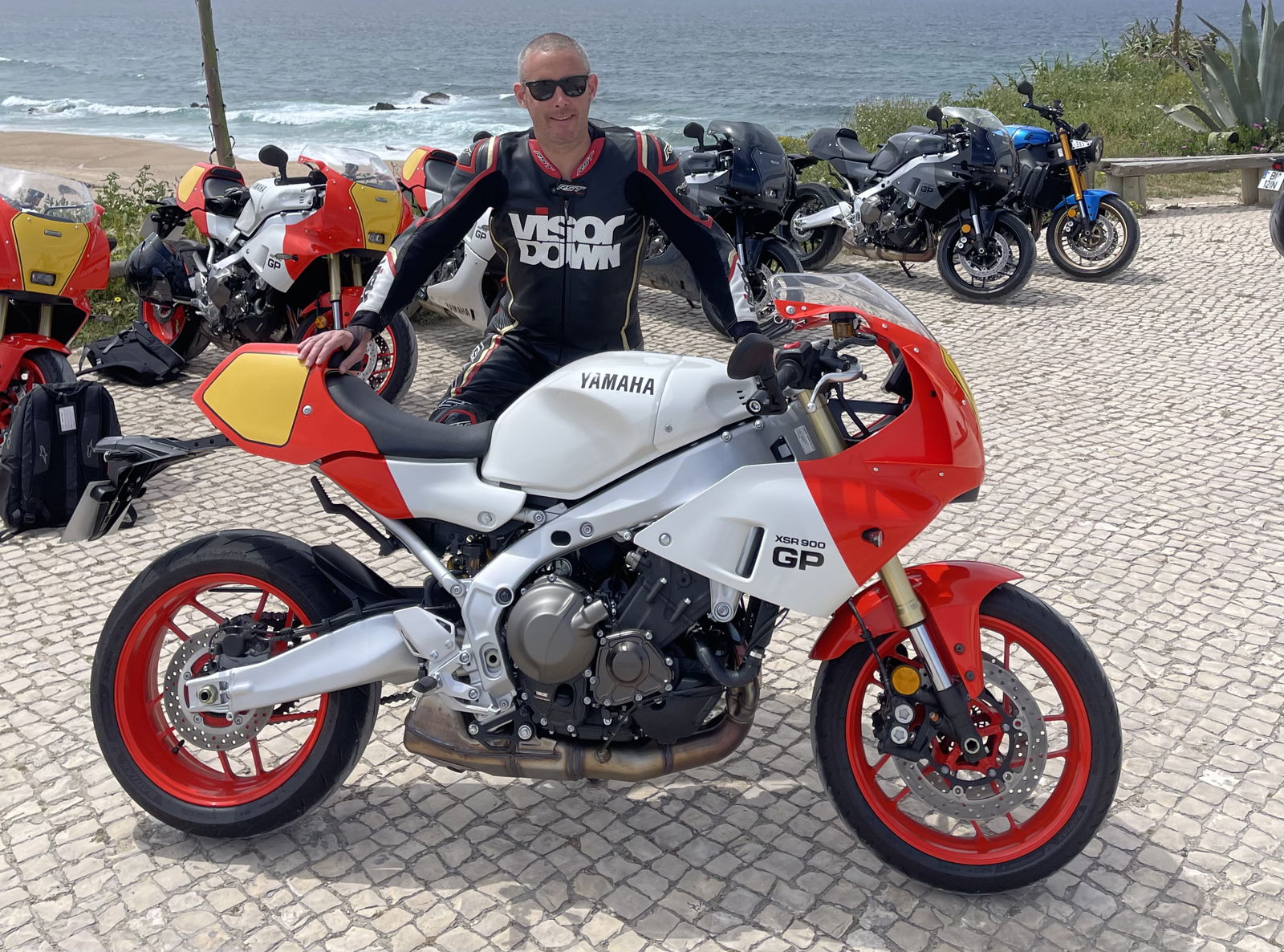
The new XSR900 GP has a hell of a lot going for it including top-spec electronics, a highly capable chassis, a beautiful, punchy engine, long service intervals and, of course, that retro styling that is like no other modern bike on the market. And that final point really is this bike’s USP, it’s a very unique and interesting proposition, and it’s the uniqueness that I really like. I’ve never ridden anything, from any manufacturer that gets as much attention as this thing does. Bikers gaze on trying to figure out if this is some restomod road racer from back in the day, and non-riders just point and take pictures because they recognise that fag-packet paint job and assume you’ve nipped out on your race bike for a sunny ride out. We even had an entire playground of primary school kids clamouring at the playground fence and cheering for us to rev the engines and rattle the bikes off the rev-limited. So we did, obviously.
Now, some of that could be the Miguel Olivera Effect, although I think people see this bike and recognise it’s something a bit different, a bit special. It’s something I enjoyed feeling while testing it, the XSR900 GP feels very special. Riding it is an event. It’s the one you save for those perfect days when you know the bike meet will be heaving and you just want to turn up on the coolest-looking thing this side of an OW01.
Yes, it handles superbly on the road and track. Yes, it’s got more fancy electronics than an entire Grand Prix paddock of the 1980s, and yes it is very fast. But this doesn’t feel like a bike you buy for those reasons. You go out and buy a bike like this because of the way it makes you feel, when you’re riding it, when you glance back at it when you’ve parked it outside Caffeine and Machine, and every time you close the garage door.
This bike does that.
Yamaha XSR900 GP Trackday Update
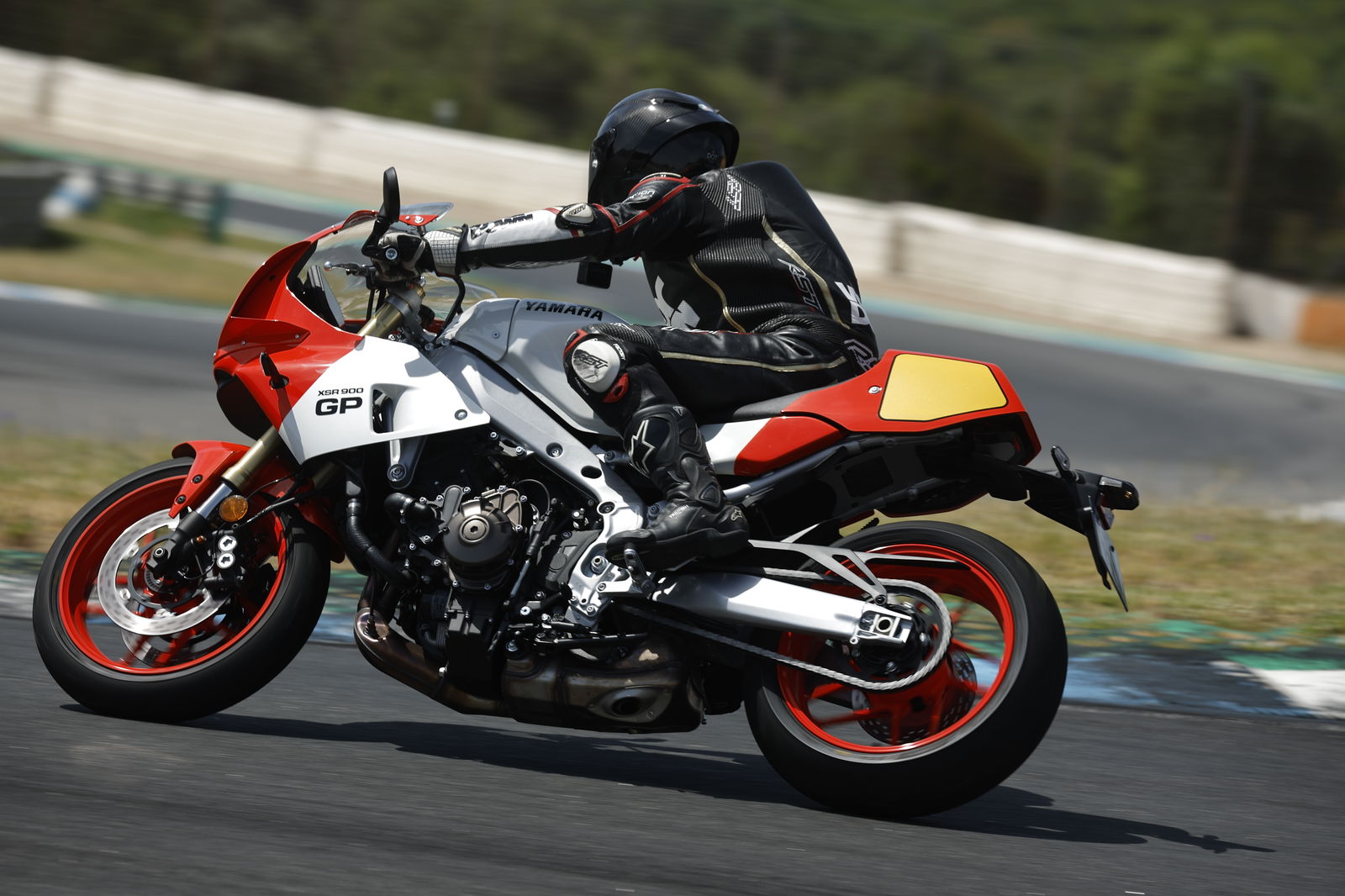
As the launch ride for the XSR900 GP didn’t feature proper track sessions, simply ‘curated’ photo opportunities on the Estoril circuit, we were very keen to get a proper day on track with the retro Yamaha. Thankfully the lovely people at the Yamaha Track Experience had a space on one of its Donington trackdays, and with the summer sun beating down on the East Midlands venue, the scene was set for a corker of a day.
We had seven 20-minute sessions to get through on the day, and the bike was totally stock, with no changes made to the suspension and only pressure dropped out of the tyres. Right out of the box, it’s clear that the GP is just as forgiving on the track as on the road. The easy access to usable torque means if I’m lazy with gear shifts the GP doesn’t punish me as much on the straights as it would if I was riding an inline four-cylinder 600cc supersports bike.
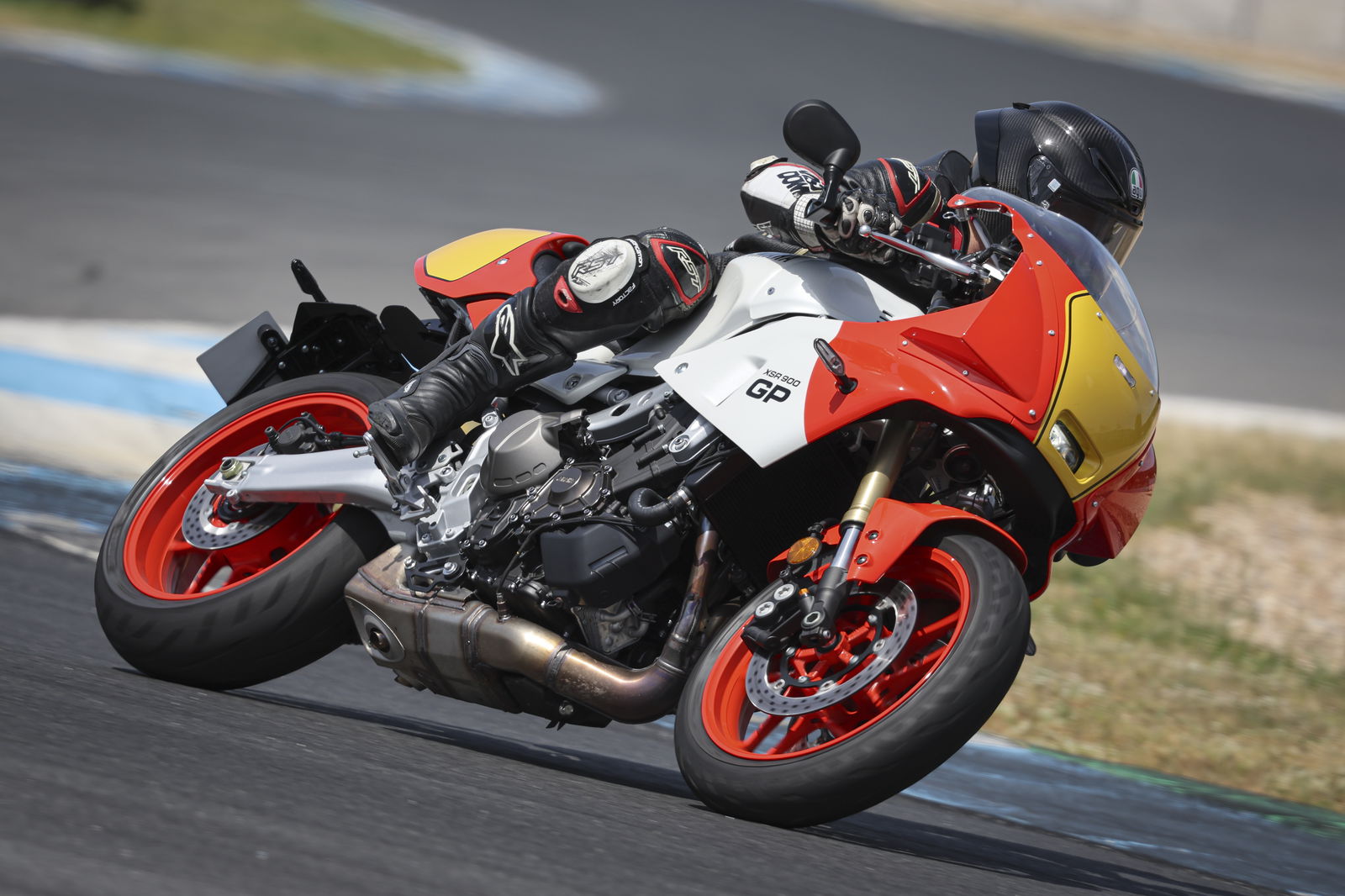
And while we are on the subject of supersport 600s, I had a decent little battle with a chap riding an R6 for most of the day, although his bike was a dedicated trackday machine - so no lights mirrors or indicators, and he was running slicks. Really the only places where the R6 would have the jump on the heavier and less focused GP was in the longer, faster corners, where he could lean more on the extra grip of the slick tyres, while I was teetering on the edge of adhesion in the near 30-degree heat.
In search of a bit more grip in the faster turns, the team from the Yamaha Track Experience suggested taking my pressures down a bit so with around 10psi dropped both front and rear (once the tyres were cool) I headed out for the final few sessions. The difference in cornering performance was instantly noticeable with the GP now giving much more edge grip without losing out on too much agility. Had I had some more time on the bike the only other thing I’d like to have tweaked is the suspension. The bike on the road setting is perfectly rideable on track, but a bespoke setup by a suspension expert would be ideal for just a little more support on corner entry and exit.
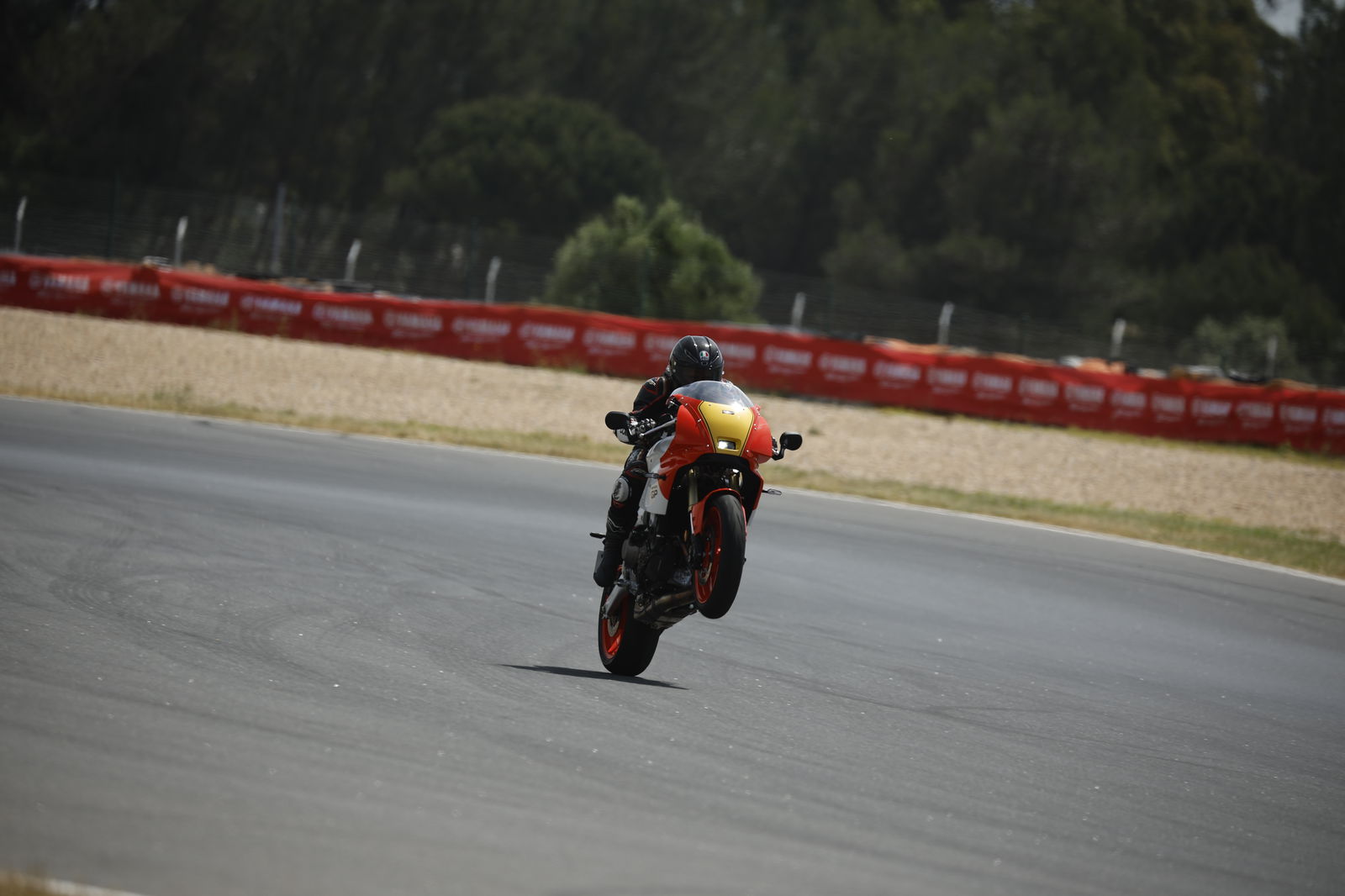
To sum up my time on track with the XSR900 GP. Donington felt like the perfect venue for the bike, given its retro styling, tying in with the track's historical links to Grand Prix racing from years gone by, and its fast and flowing nature, which really played to the strengths of the GP. Another point that is well worth mentioning is the elephant in the room, the much-talked-about and long-awaited R9. It’s widely understood that the R9 and XSR900 GP will be very similar to each and only differentiated through electronics, suspension and braking equipment. If the XSR900 GP is even the merest hint as to what the R9 will be like once it does land, it’s going to be an absolute corker of a bike!
2024 Yamaha XSR900 GP Video Review
Yamaha XSR900 GP specs
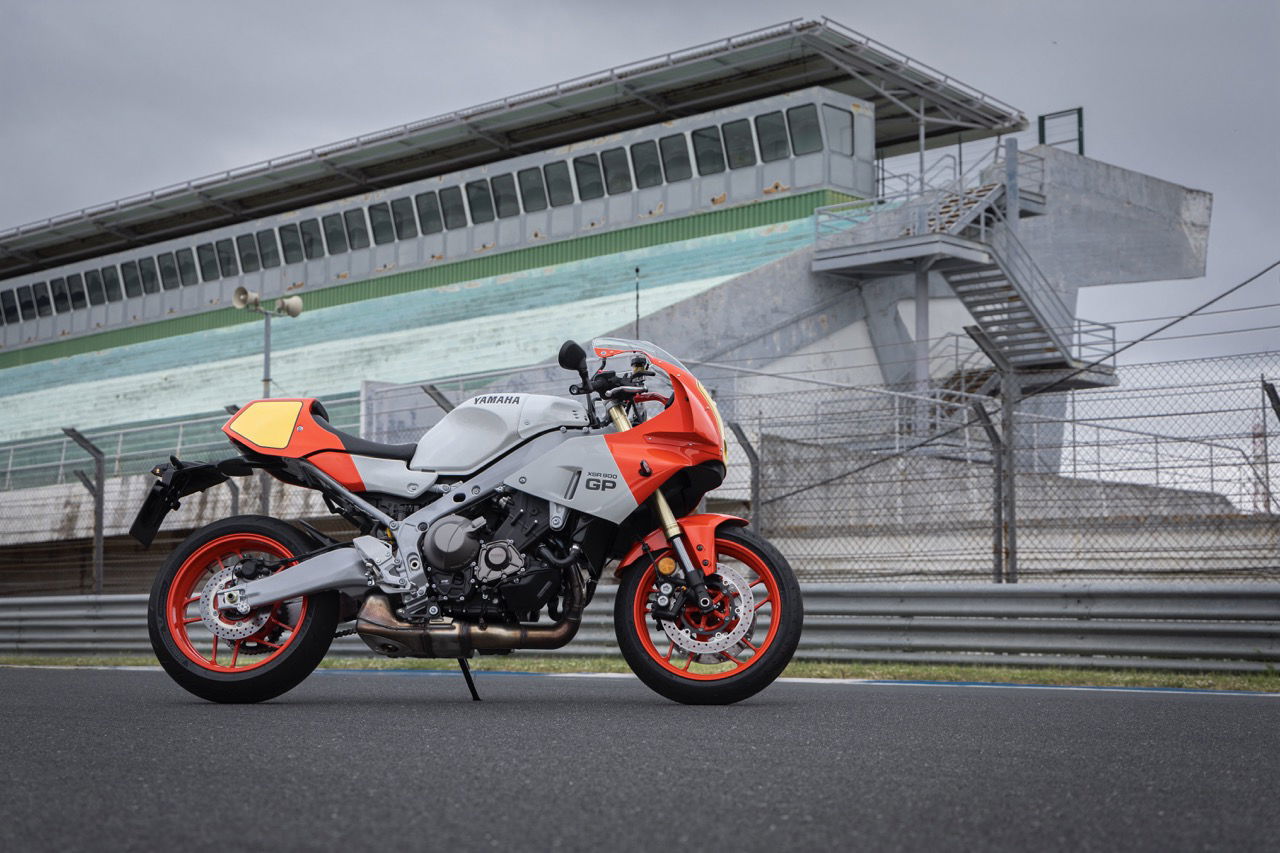
Engine | 4-stroke, Liquid-cooled, DOHC, 4-valves, 3-cylinder |
Capacity | 890cc |
Bore/Stroke | 78 x 62.1mm |
Power | 87.5kW (117.3bhp) @ 10,000rpm |
Torque | 93Nm (68.5lb ft) @ 7,000rpm |
Transmission | Six-speed, wet slip/assisted clutch |
Quickshifter | Yes |
Suspension - F | KYB fully adjustable fork - 130mm travel |
Suspension - R | KYB fully adjustable link-type rear shock - 131mm travel |
Front brake | Twin four-piston hydraulic dual disc brake - 298mm floating disc |
Rear brake | Two-piston hydraulic single disc brake - 245mm fixed disc |
Rake | 25° |
Trail | 110mm |
Tyre - F | 120/70ZR17M/C (58W) Tubeless |
Tyre - R | 180/55ZR17M/C (73W) Tubeless |
Wheelbase | 1,500mm |
Seat height | 835mm |
Wet weight | 200kg |
Fuel capacity | 14 litres |
A2 variant | No |
